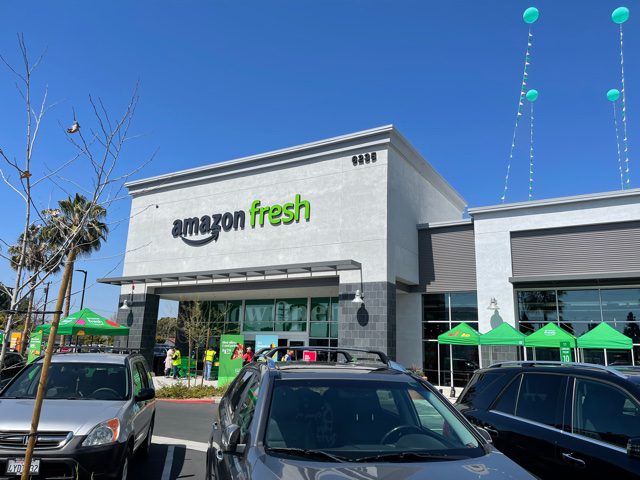This week I decided it was time to check out the new Amazon Fresh store that had opened near our offices in Southern California. For some of us, the fact that Amazon has opened about a dozen free-standing retail grocery stores in the U.S. is perplexing. First they bought Whole Foods. We all figured that was their retail expansion strategy. Then they closed the Whole Foods small store format “365” stores, but now Amazon Fresh stores are popping up. The resemblance is clear.
After my visit, I decided that Amazon’s move made a little more sense. It boils down to logistics. I visited my store at 12:30 p.m.—the normal lunch hour in our area. There were almost no customers in the store, but there were dozens of Amazon Fresh employees pushing baskets around the store pulling orders for Amazon online shoppers who have placed orders. Some customers pick up their orders on site, as there were dozens of numbered parking spots outside the store. Others will have them delivered to their home.
It feels like Amazon Fresh 2.0. By having their own retail stores (instead of developing a network of large warehouses/distribution centers), they are using the retail outlets as their “warehouses,” which can do double duty as a grocery store if a shopper so desires. It’s a much smaller investment to build these.
Like other retailers who are “testing the waters” with their unique format (Fresh and Easy, Lidl, Aldi, Haggen, etc.) they have some bugs to work out on the product mix. Buying and selling perishable items like produce is definitely an art. If you over-order, you will throw product away causing financial losses. If you under-order, you disappoint your customers when you cut their orders and the lifetime value of that shopper may decline.
But there is something very positive about Amazon Fresh opening stores, and that is that they are reducing their carbon footprint when it comes to corrugated packaging material. You know what I mean—you order something on Amazon, or maybe you order five things on Amazon, and they all come in separate boxes. And some of those boxes are tremendously oversized. What you may not realize is that the incredible appetite Amazon has created for “ordering online” has created a paper and packaging shortage like we’ve never seen in our lifetimes.
Companies who manufacture corrugated boxes are working overtime. They cannot keep up with demand. The number of forests being cut down is skyrocketing, and I suspect the impact on the environment is NOT a net positive. True, we may not drive ourselves to the grocery store as often, using less fossil fuel. But, I don’t think we can recycle as much cardboard as we are all using when we order on Amazon. How do I know it is out of control? Well, I cannot dispose of all my “recycling” each week on trash day due to the overfilled bin.
So, that’s why I think it is better, as a consumer, to shop locally. It may take a full hour to make a list, drive to the store, do your grocery shopping, drive home and put everything away, but I feel better about spending an hour doing my own shopping, smelling the produce and enjoying the bright and vibrant colors as I hand-select my own food, vs. gaze outside my front door to stacks and stacks of cardboard boxes.
If you’re a parent of a toddler and think it’s a hassle to go grocery shopping with them, how about turning the shopping trip into a teachable moment? Let your kid’s help you pick out your food. Teach them what to look for when picking a banana or berries. What a great opportunity to prepare young ones for life on their own! Plus, it gives you quality time with them while you shop.
I may be old-school by doing my grocery shopping in person. I know my 31-year-old daughter Alex says she doesn’t remember the last time she went into a grocery store to shop. She orders everything online. And you probably know people just like her.
So, next time you are trying to figure out if you should go to the store or order online, think about that overfilled recycling bin at your house. There is a price for all of us to pay—for our planet to pay—when we produce waste.
I know for me, I will be figuring out ways to make my shopping experiences enjoyable, vs drudgery.
I would love to know what you think! Please share your thoughts with me.
Karen





